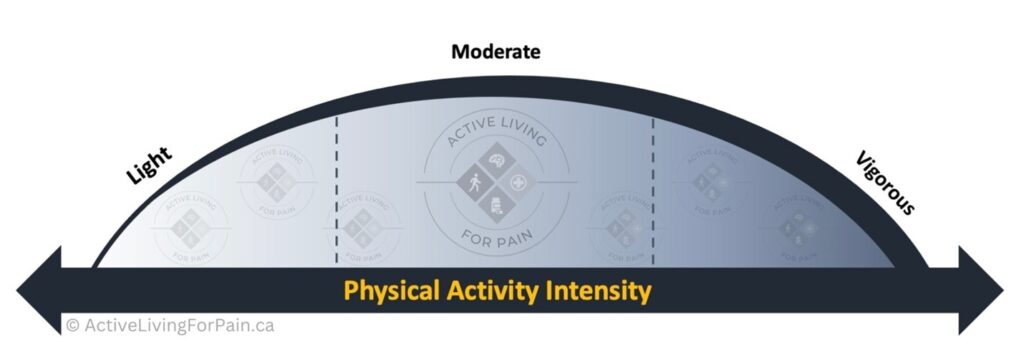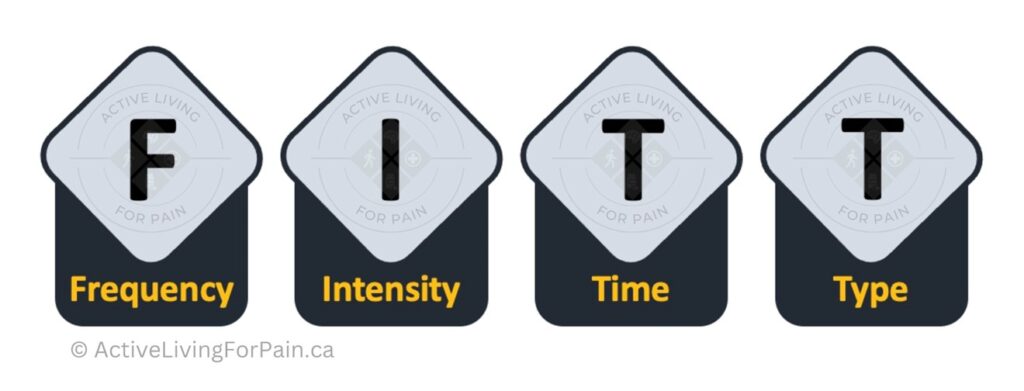What is physical activity?
Physical activity includes any movement of your body produced by your muscles that requires effort to do. Physical activity can range from going for a walk to running in a marathon. It also includes other activities that increase your heart rate such as gardening, household chores, swimming at the beach, or taking the stairs instead of an elevator!
Physical activity can help you manage chronic pain. Research has shown that when people are physically active over many weeks and many months, their pain has less of a negative impact on them. They are better able to do their daily activities, like going for groceries or doing yard work. They also report a better quality of life!
Will my pain get worse when I am doing physical activities?
The short answer is that it depends. Everyone has slightly different reactions to physical activity. Some find that their pain increases when they first start being active, then subsides as the session goes on. Others need to be aware and manage their pain throughout. It is important to know your body. Even people who don’t live with chronic pain get sore after doing a higher level of activity or new activities. Usually this soreness, called Delayed Onset Muscle Soreness (DOMS), starts the next day and lasts for one to three days. For people living with chronic pain, this soreness may start earlier and last longer. The good news is that the more you are physically active, the less DOMS you get.
When you feel pain, it is normal to try to protect your body by resting or avoiding certain activities. However, over time, choosing to be inactive can lead to less mobility, muscle weakness, and more fatigue. These can lead to even more pain and disability.
If you are unsure of how your body will react to physical activity, try a short or low intensity activity, like a gentle walk, to see how your body feels. There are a lot of different factors that can influence how your body reacts to physical activity. We recommend tracking your pain before, during, and after you do physical activity. This can help you to better understand how your pain changes or reacts to different activities that you do. See our tips and tricks for more ideas of how to be active while living with pain.
Although physical activity can cause different reactions for different people, it is important to continue being active over many weeks and months. Regular activity is an effective tool for those with chronic pain. It can reduce nervous system sensitivity, pain, and fatigue. Improvements in sleep, mood, and overall physical function also come from regular physical activity.
Can I do physical activity when I have pain?
Regular activity is recommended for those living with chronic pain. Pain isn’t always a bad thing when it comes to physical activity. Although you may be less active on some days because of your pain, it’s important to remember that doing a little bit of activity is better than none. It is also important to understand what type of pain you are having and whether it’s typical during the activity. Some stiffness or soreness can be expected after you do physical activity. However, depending on your type of pain, certain physical activities might aggravate your pain. Click here to read more about the different types of pain. If your chronic pain increases with activity to a level that you can’t manage, or if you develop a new pain, you may benefit from changing the activity or changing how you manage your pain during activity. Consider speaking to your healthcare provider or physical activity instructor for further advice.
Like most things that improve with physical activity (e.g., better sleep, healthy body weight, increased strength and function), pain does not improve overnight. Although you may get increased pain when you start or try new activities, you can still do physical activity when you experience pain. You might just need to modify your activity or add new ways to manage your pain.
How much physical activity should I do?
Even a little bit of movement is good for you and can help with your pain! People usually see greater benefits in their health and well-being if they can be physical active for 150 minutes or more each week. That amount of activity may seem impossible if you’re just starting to be active. Remember to start low and go slow. That means, start at a low level of activity that you know you can do without flaring up. After a few days of being active at that level, increase your activity level (e.g. minutes of activity) slightly. Celebrate each time you choose to be active, regardless of the level of activity that you do. Although this may seem tough at first, the goal is to slowly increase your physical activity over time. Use the 50% Physical Activity Guideline and our Tips and Tricks to help you start!
What types of physical activity are good for people with chronic pain?
There are many different types of physical activity to choose from while living with chronic pain. Muscle building strength activities, heart pumping aerobic activities, and leisure activities can all help you to better manage your pain. What is crucial for long-term pain management is to keep going or try different activities until you find some that work best for you! Although research has not found a single type or dose of activity that is most effective, continuing to be active is what matters to help you live well with chronic pain. The best type of activities for you are the ones you enjoy!

Remember that there are benefits to doing each type of physical activity, and all intensity levels can be incorporated in daily life! Light activity can help reduce pain in the long-term. Moderate activity causes the body to produce many endorphins that can reduce pain during and after activity. While any activity that is moderate or vigorous intensity can improve fitness, energy levels, mood, and quality of life.

How can I modify my physical activity when I have pain?
When pain occurs, you can modify your activity by using the FITT Principle. FITT is anacronym you can use to continue being active while managing pain by changing the Frequency, Intensity, Time, or Type of activity. For example, is running too much for your chronic pain? Try walking instead. Or start with a short jog and increase the amount of time to a longer run. Or maybe you could try biking or swimming instead! See our tips and trick s for more information about FITT and how you can change your current physical activity or select new activities.
There are always going to be different options you can try to have better control over your pain. Remember, not all physical activities will be right for you. You need to find the activities that will help you to manage your pain best!



